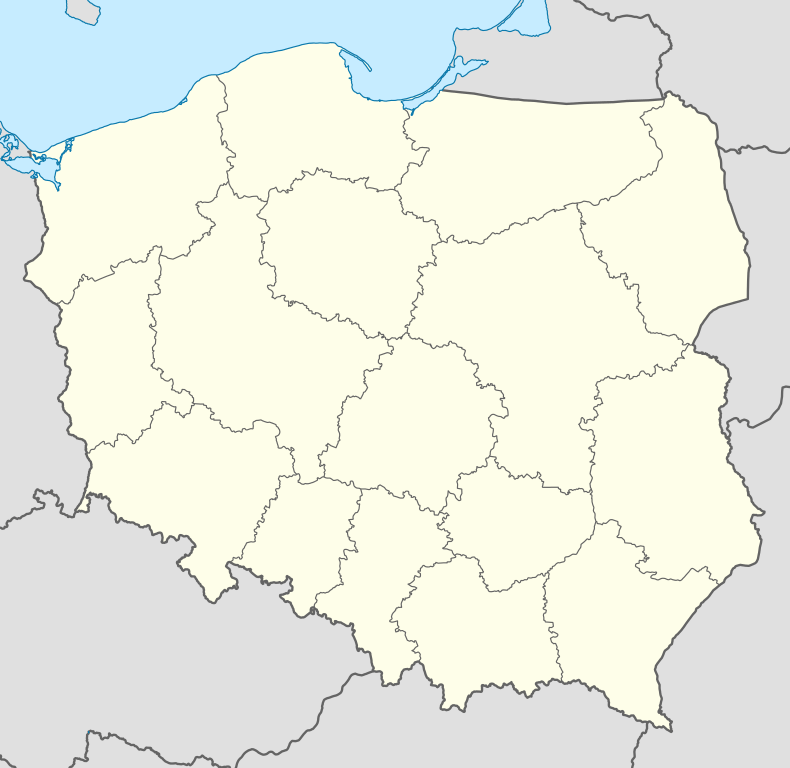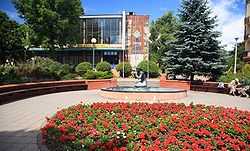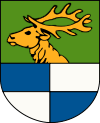Giżycko
| Giżycko | |||
|---|---|---|---|
|
Giżycko | |||
| |||
 Giżycko | |||
| Coordinates: 54°2′24″N 21°45′32″E / 54.04000°N 21.75889°E | |||
| Country |
| ||
| Voivodeship | Warmian-Masurian | ||
| County | Giżycko County | ||
| Gmina | Giżycko (urban gmina) | ||
| Established | 1335 | ||
| Town rights | 1612 | ||
| Government | |||
| • Mayor | Jolanta Piotrowska | ||
| Area | |||
| • Total | 13.87 km2 (5.36 sq mi) | ||
| Highest elevation | 142 m (466 ft) | ||
| Lowest elevation | 116 m (381 ft) | ||
| Population (2006) | |||
| • Total | 29,667 | ||
| • Density | 2,100/km2 (5,500/sq mi) | ||
| Time zone | CET (UTC+1) | ||
| • Summer (DST) | CEST (UTC+2) | ||
| Postal code | 11-500 | ||
| Area code(s) | +48 87 | ||
| Car plates | NGI | ||
| Website | http://www.gizycko.pl | ||
Giżycko [ɡʲiˈʐɨt͡skɔ] (German: ![]() Lötzen , Lithuanian: Lėcius; former Polish: Lec) is a town in northeastern Poland with 29,796 inhabitants (2004). It is situated between Lake Mamry and Lake Niegocin, and has been within the Warmian-Masurian Voivodeship since 1999, having previously been in the Suwałki Voivodeship (1975–1998). It is the seat of Giżycko County.
Lötzen , Lithuanian: Lėcius; former Polish: Lec) is a town in northeastern Poland with 29,796 inhabitants (2004). It is situated between Lake Mamry and Lake Niegocin, and has been within the Warmian-Masurian Voivodeship since 1999, having previously been in the Suwałki Voivodeship (1975–1998). It is the seat of Giżycko County.
History
The first known settlements in the area of Giżycko date back Roman times and are connected to Amber Road in vicinity of which Giżycko was located.[1] A defensive grod was known to exist in the area, and some legent claims that in the IX it was ruled by king known as Izegup or Jesegup.[1]
In 1008 Bolesław I Chrobry sent an expedition to Christianize the Old Prussians ; according to the legend the missionary Bruno of Querfurt was killed by Sudovians near Lake Niegocin in 1009, and a memorial the Bruno – cross was erected near Loetzen in 1910.
The Teutonic Knights built a castle in Prussia named Lötzen or Letzenburg and the town was first mentioned in 1340 as Lezcen, derived from Prussian language: lezuns. Lötzen was administered within the Komturei of Balga. The settlement near the castle received town privileges, with a coat of arms and seal, in 1612 while part of the Duchy of Prussia.
Lötzen became part of the Kingdom of Prussia in 1701 and was made part of the province of East Prussia in 1773. In 1709/10 the plague claimed 800 victims, only 119 inhabitants survived.[2] In the 19th century, a Lutheran church designed by Karl Friedrich Schinkel was erected in the center of the town. Lötzen became part of the German Empire in 1871 during the Prussian-led unification of Germany.
1844–1848 the “Feste Boyen“, a fortress named after the Prussian war-minister Hermann von Boyen, was built on a small landtongue between lake Mamry (Mauersee) and lake Niegocin (Löwentinsee). This fortress is one of the largest and best conditioned fortresses of the 19th century. In 1942–1945 it was the headquarters of the German military intelligence service (Fremde Heere Ost) under Reinhard Gehlen.
As a result of the treaty of Versailles on 11 July 1920 the East Prussian plebiscite was organized under the control of the League of nations, which resulted 99,97% of votes to remain in Germany (29,378 total) and 0,03% for Poland (9 total). At the time, both German and Polish governments believed that the outcome of the plebiscite was decided by the ongoing Polish-Bolshevik War which threatened the existence of the newly formed Polish state itself. As a result, even many Poles of the region voted for Germany out of fear that if the area was allocated to Poland it would fall under Soviet rule.[3]
In the 1930s Lötzen was the garrison of several military units of the Wehrmacht as a Sub-area Headquarter of Wehrkreis I, which was headquartered at Königsberg. Staff-, maintenance- and guardtroops of Hitler's headquarter Wolfsschanze and the Oberkommando des Heeres (OKH, army highcommand) were also based in or nearby Lötzen. The OKH was based at the Mauerwald area, ca. 10 km north of Gizycko, an undestroyed bunker system.
The town was occupied by the Soviet Union's Red Army in 1945 during World War II and placed under Polish administration after the war ended. The German-speaking populace who had not evacuated during the war were subsequently expelled westward. The town was renamed Giżycko in 1946 in honor of the Masurian folklorist Gustaw Gizewiusz, a 19th-century Evangelical-Lutheran pastor in southern East Prussia, who had greatly supported Polish language and Polish culture.
-

Bruno of Querfurt Hill and Cross in Giżycko. View from Lake Niegocin
-

Boyen fortress
-

Boyen fortress
Demographics[4]
| Year | Population |
|---|---|
| 1875 | 4,034 |
| 1880 | 4,514 |
| 1890 | 5,486 |
| 1925 | 10,552 |
| 1933 | 11,847 |
| 1939 | 14,000 |
| 2006 | 29,667 |
Sports
When Poland made the so far only international appearance in bandy, the city was represented.[5]
Education
Primary School
- Szkoła Podstawowa nr 4 im. I Dywizji Piechoty
- Szkoła podstawowa nr 5
- Szkoła Podstawowa nr 6
- Szkoła Podstawowa nr 7 im. Janusza Korczaka
Middle School
- Gimnazjum nr 1 w Giżycku im. Jana Pawła II
- Gimnazjum nr 2 w Giżycku im. Chwały Oręża Polskiego
- Katolickie Gimnazjum im. św. Brunona z Kwerfurtu
- Zespół Szkół nr 1 im. Mikołaja Kopernika
High School
- I Liceum Ogólnokształcące im. Wojciecha Kętrzyńskiego
- II Liceum Ogólnokształcące im. Gustawa Gizewiusza
- Zespół Szkół Elektronicznych i Informatycznych im. Komisji Edukacji Narodowej
- Zespół Szkół Kształtowania Środowiska i Agrobiznesu
- Zespół Szkół Zawodowych
- Katolickie Liceum im. św. Brunona z Kwerfurtu
College
- Medyczne Studium Zawodowe im. Hanny Chrzanowskiej
- Prywatna Wyższa Szkoła Zawodowa
Notable residents
- Fritz Milkau (1838–1918) librarian
- Adalbert von Winckler (1838–1918) aka Wojciech Kętrzyński, Pro-Polish activist of Kashubian-German descent
- Paul Davidson (1867–1927), film producer
- Rudolf Nadolny (1873–1953) diplomat
- Franz Pfemfert (1879–1954), publisher
- Horst Gerlach (1919–1990) member Bundestag, European Council
- Lothar Gall (born 1936), historian
- Jan Bułhak (1876–1950), pioneer of photography in Poland, resettled by communists 1945
- Maria Pakulnis actress
- Mateusz Kusznierewicz sailor
- Jolanta Piotrowska, Mayor and President of the Bandy Federation of Poland[6]
International relations
Twin towns — Sister cities
Giżycko is twinned with:
References
- ↑ 1.0 1.1 History Giżycko City official website
- ↑ Kossert, Andreas (2006). Masuren. Ostpreußens vergessener Süden (in German). Pantheon. ISBN 3-570-55006-0.
Kossert, Andreas (2004). Mazury, Zapomniane południe Prus Wschodnich (in Polish). ISBN 83-7383-067-7. - ↑ Debo, Richard K. , "Survival and consolidation: the foreign policy of Soviet Russia, 1918-1921", McGill-Queen's Press, 1992, pg. 335
- ↑ Deutsche Verwaltungsgeschichte Provinz Ostpreußen, Kreis Lötzen
- ↑ Bandy 2006, World Championships
- ↑
- ↑ Co Giżycko łączy z Ghazni?
External links
| Wikimedia Commons has media related to Giżycko. |
- Municipal website
- Tourism website
- 1882 Map of East Prussia with Lötzen between Lakes Mauer & Löwentinsee
- festeboyen.pl (Polish)
Coordinates: 54°03′N 21°46′E / 54.050°N 21.767°E
| |||||||||||||||||



